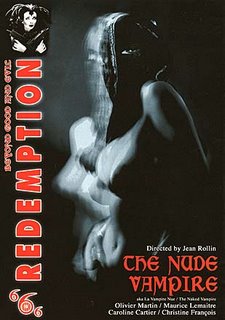 Directed by: Jean Rollin
Directed by: Jean Rollin
Release Date: 1969
Contains spoilers
The Nude Vampire maybe should have been entitled The (may as well be) Nude (not really a) Vampire. The reason for saying this is that the ‘vampire’ (Caroline Cartier, in a role credited as vampire) spends most of her time wearing see-through chiffon and because, by the end of the film, we discover that the character isn’t really a vampire. That said I believe that the film is a genre film which is why I have written a review rather than Vamp or Not? piece and I have kind of put the cart before the horse by saying all that.
This was Jean Rollin's second feature and for those who have never seen Rollin movies, well let us just say that he is a French director who is often very surreal and has a propensity to throw much nudity and fetishism into his creations.
This is possibly as surreal a Rollin film that I have seen (with the possible exception of Rape of the Vampire) and the psychedelic or, even, dreamlike nature of the film can cause you to wonder whether there is actually a story under it all. There is and it is strangely compelling.
We start with a masked man in a doctor’s coat. A hooded girl is brought to him by hooded men and he takes a sample of blood. We then see a girl sneaking out of a town house, she is the ‘vampire’.  She is followed by men in animal masks and one wonders why her escape remains furtive rather than one of fleeing as they are mere yards behind her. She comes across a man, Pierre (Olivier Martin), and touches his face. He sees the extravagantly masked men and flees with her until they are surrounded. One of the masked men shoots the girl, Pierre climbs to safety and they carry her body back to the Town House. Several people in evening dress enter the Town House gate and Pierre tries to follow. He is stopped because he has no invitation – which is the first dialogue we get.
She is followed by men in animal masks and one wonders why her escape remains furtive rather than one of fleeing as they are mere yards behind her. She comes across a man, Pierre (Olivier Martin), and touches his face. He sees the extravagantly masked men and flees with her until they are surrounded. One of the masked men shoots the girl, Pierre climbs to safety and they carry her body back to the Town House. Several people in evening dress enter the Town House gate and Pierre tries to follow. He is stopped because he has no invitation – which is the first dialogue we get.
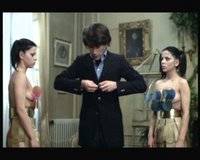 Cut to Pierre at home, being ‘served’ by identical twins (Catherine and Marie-Pierre Castel) in bizarre outfits. His father, Georges Radamante (Maurice Lemaître), enters the room and tells him that he was seen near his Town House and to stay away. He can have all the money and girls he wants but he must stay out of his father’s business. He decides he will discover his father’s secrets.
Cut to Pierre at home, being ‘served’ by identical twins (Catherine and Marie-Pierre Castel) in bizarre outfits. His father, Georges Radamante (Maurice Lemaître), enters the room and tells him that he was seen near his Town House and to stay away. He can have all the money and girls he wants but he must stay out of his father’s business. He decides he will discover his father’s secrets.
We cut to the scene of a woman dancing for Radamante and his two associates Fredor (Jean Aron) and Voringe (Bernard Musson). It is a somewhat psychedelic exploitation scene that I mention for three reasons. Firstly because we hear the men talking about the risks they are taking. Secondly because we meet Radamante’s secretary Solange (Ursule Pauly) and thirdly because of a brief scene where we see a blonde dancer on the telephone saying that she will follow him (unnamed), but cuts the conversation when Solange enters.
We cut to night and people in formal wear going to the Town House, Pierre mugs a straggler for his invitation and gets inside. He ends up in a room where, almost ritualistically, a projection slide of a woman is selected. She is one of the attendees. She steps forward, takes a gun and blows her own brains out – though my description is more powerful than the most unconvincing gunfire noise and suicide scene you’ll see in a movie. Everyone puts on hoods and a hood is placed on the corpse. She is carried to a stage and the ‘vampire’ comes down some stairs. She tries to lift the hood from the corpse, is stopped and then licks at the blood which has dripped to the neck. The curtains close and another slide is chosen – it is Pierre. He takes the gun but shoots the slide chooser and runs. He is hunted by masked men but the one who corners him is stabbed by an oriental lady. He meets a man in a cape (Michel Delahaye), credited as the Grandmaster, who tells Pierre to go to his father’s offices as more mysteries await.
Again cut, this time to a painter, Robert (Pascal Fardoulis), who, after she does some self touchy-feely, is about to get down and dirty with his model. The phone rings, Pierre wants picking up and taking to the offices. 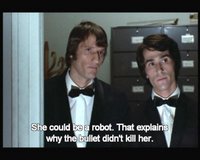 When they arrive, both in formal wear, they find pictures of the girl and records of blood types of night workers. Perhaps she is a robot, suggests Robert. Meanwhile Radamante has been told of the incident at the Town House, though Pierre is not named, has had it shut down and the girl moved. Alarms go off in the office and everyone puts hoods on as the girl is brought through but she unmasks Robert and he and Pierre are caught. Pierre is taken to his father.
When they arrive, both in formal wear, they find pictures of the girl and records of blood types of night workers. Perhaps she is a robot, suggests Robert. Meanwhile Radamante has been told of the incident at the Town House, though Pierre is not named, has had it shut down and the girl moved. Alarms go off in the office and everyone puts hoods on as the girl is brought through but she unmasks Robert and he and Pierre are caught. Pierre is taken to his father.
His father explains that she has a rare blood disorder and cannot go out in the sun but it does cause miraculous healing. That she is worshipped by fanatics as a Goddess and those worshippers are a suicide cult. He explains that he is searching for a cure for her and needs an identical blood-type, someone with the same disease and the reason everyone wears hoods is that she has never seen another human (yeah I know) and he doesn’t want her to know how different she is. He says to Pierre to give him 48 hours to prove this to him.
Radamante then sells the Town House and buys a remote chateau and transports the girl there. The person who sells him the chateau is the grandmaster. Radamante confides to his associates that others of her species might be looking for her.
Under Radamante’s orders Solange goes to Robert. She tells him she needs help as the girl is a vampire and Radamante wants to breed her with another in order to steal her immortality – this is pure "Bond villain giving plot away" (though not so simple in Rollin’s world) and then shoots Robert dead. Pierre is then told that his father has gone away.
It is here that things have gotten interesting story-wise, despite the weirdness. Here we have some form of scientist or doctor, Radamante, who has captured a vampire and is trying to find a male in order to breed them. The vampire has a different blood-type (in fact is a whole other species), heals quickly, must avoid sunlight and feeds on blood – but as I have intimated it is not so simple.
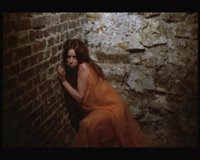 The two associates are woken by the sound of drums and get Radamante. Meanwhile the oriental woman releases the ‘vampire’ from her cell. Having released her from her cell she then meets the girl on the roof, cuts her own breast and allows the vampire to feed. She then signals the Grandmaster to let him know the girl is loose. The three men discover that their drivers are dead and then see the girl, they try to shoot her, to no effect, and run.
The two associates are woken by the sound of drums and get Radamante. Meanwhile the oriental woman releases the ‘vampire’ from her cell. Having released her from her cell she then meets the girl on the roof, cuts her own breast and allows the vampire to feed. She then signals the Grandmaster to let him know the girl is loose. The three men discover that their drivers are dead and then see the girl, they try to shoot her, to no effect, and run.
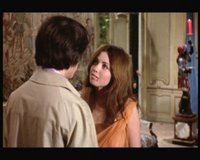 Pierre comes in and walks straight into the ‘vampire’ who touches his face. Radamante takes them all to a room to prepare for a siege and admits he is searching for immortality. Pierre leaves and meets the twins who wear the same ring as the Grandmaster and the oriental woman. They tell Pierre that he will wear it some day and that his father has had Robert killed (this is observed by Solange). He then finds the Grandmaster who tells him that what he will see is not real, as his father and the associates believe in vampires they will see vampires. Pierre is destined for someone, obviously the girl.
Pierre comes in and walks straight into the ‘vampire’ who touches his face. Radamante takes them all to a room to prepare for a siege and admits he is searching for immortality. Pierre leaves and meets the twins who wear the same ring as the Grandmaster and the oriental woman. They tell Pierre that he will wear it some day and that his father has had Robert killed (this is observed by Solange). He then finds the Grandmaster who tells him that what he will see is not real, as his father and the associates believe in vampires they will see vampires. Pierre is destined for someone, obviously the girl.
Solange attacks the twins and, with a most unconvincing swipe of a candlestick, knocks them down the stairs, apparently dead. She reports to Radamante but the Grandmaster comes in and carries the girl away, unaffected by bullets. He passes her to Pierre and then signals an attack where dozens of people (including the blonde dancer, remember her from earlier), carrying torches, walk slowly into the chateau. 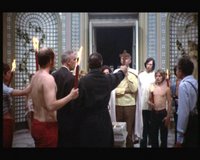
Eventually cornered, and realising that bullets are useless, Radamante holds up a crucifix that the Grandmaster takes from him and then hands back and then simply leaves as the men know they are defeated. Meanwhile the twins, with burnt faces, go after Solange – who gets away to a graveyard and then just 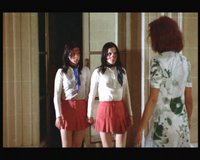 collapses on a grave. Pierre is sent to see his father by the Grandmaster, a pointless exercise as he simply looks at him and then leaves, but it means his father can follow him to the finale. Outside Pierre follows the Grandmaster’s voice to a house, in which he is given a ring (the same as the Grandmaster’s) and told to go through a curtain.
collapses on a grave. Pierre is sent to see his father by the Grandmaster, a pointless exercise as he simply looks at him and then leaves, but it means his father can follow him to the finale. Outside Pierre follows the Grandmaster’s voice to a house, in which he is given a ring (the same as the Grandmaster’s) and told to go through a curtain.
Radamante wants to follow but the associates abandon him. As they leave they discuss the situation. “Was she a vampire?” asks one. “She was something,” is the only answer.
Radamante jumps through the curtain and ends up on a beach. Everyone there has grey faces. 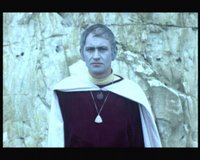 He fires his gun but it is useless, they are in another dimension. The Grandmaster tells Radamante that Radamante himself was the true vampire, he made the girl feed on blood and kept her from sunlight. They are not vampires, they are mutants – the new evolution of humanity, immortals.
He fires his gun but it is useless, they are in another dimension. The Grandmaster tells Radamante that Radamante himself was the true vampire, he made the girl feed on blood and kept her from sunlight. They are not vampires, they are mutants – the new evolution of humanity, immortals.
Okay, I said it was bizarre. There is some wild jazz over parts of the soundtrack that really works and the cinematography and costuming make this surreal experience dreamlike. The acting is poor, the associates seem permanently worried, Pierre virtually never breaks a sweat and the ‘vampire’ just seems bemused. Yet the acting also adds to the dreamlike quality, making the characters almost like flitting figures in a subconscious fantasy.
Nothing fits into the real world, slowly pacing masked figures hunting a chiffon wearing girl in the heart of Paris could never feel real and that is the joy of the movie. That said Rollin made more commercially normal films (to a degree), which are likely a better starting point for those who have never seen his films rather than discover his films through this one. Strangely, as I watched this, I couldn't help but think of Alien Blood and, whilst the film is about evolution rather than extra-terrestrials, the later film must have been influenced by this - though Alien Blood is nowhere near as fulfilling. There are also elements that feel like they influenced Twin Peaks.
It is so difficult to score this that I rather wished I had written a Vamp or not? (As I do not score those.) As I said, poor acting and a storyline hidden amongst surrealism pushes the score down, as does the fact that there are better Rollin films out there. However the film is weirdly compelling and has all the motifs that Rollin’s fans look for – plus a large amount of naked flesh for those searching for that (though I’ve got to say I didn’t think this film worked on an erotic level particularly). I’m forced to 3.5 out of 10, most casual viewers will hate this, it is probably only for the Jean Rollin aficionados. I also realise that if you love Rollin then you might think I've scored too low, if you hate him too high - but I've tried to capture a fair mark on the quality of the film.
The imdb page is here.
Thursday, August 31, 2006
The Nude Vampire - review
Posted by
Taliesin_ttlg
at
3:36 AM
0
comments
![]()
Labels: vampire
Wednesday, August 30, 2006
Wearing your Obsession
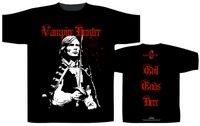
Hammer Film Productions have recently launched a Hammer shop. Amongst the merchandise available are T-Shirts and the two pictured are ones that I’ve got for myself – I couldn’t resist. There is also a ladies skinny fit vampiress shirt and another couple of Dracula ones (as well as several none vampire ones). To be honest the postage costs are a little high, for one item at least but they become more reasonable with multiple purchases, but delivery is very fast indeed – and you can’t argue with that.
To be honest the postage costs are a little high, for one item at least but they become more reasonable with multiple purchases, but delivery is very fast indeed – and you can’t argue with that.
So there you go, you can now happily wear your obsession on your chest – I know I am!
Posted by
Taliesin_ttlg
at
8:25 AM
2
comments
![]()
Tuesday, August 29, 2006
Thanks to Neil
 Many thanks to my friend Neil who gave me a surprise present of the "Fish – Return To Childhood" DVD. Fish was lead singer with Marillion and 2005 saw the 20th anniversary of their seminal "Misplaced Childhood" album and Fish played the full album live throughout the tour. I went along to the tour, a great gig, and to the extension of the tour this year – which was an even better gig. (Believe me, over the years I have been to several of Fish’s shows but I don't think I've seen better.)
Many thanks to my friend Neil who gave me a surprise present of the "Fish – Return To Childhood" DVD. Fish was lead singer with Marillion and 2005 saw the 20th anniversary of their seminal "Misplaced Childhood" album and Fish played the full album live throughout the tour. I went along to the tour, a great gig, and to the extension of the tour this year – which was an even better gig. (Believe me, over the years I have been to several of Fish’s shows but I don't think I've seen better.)
It’s great to have part of the tour on DVD. For a vampire connection the DVD does have the track "Goldfish and Clowns" from Fish's solo "Sunsets on Empire" album, with the lyric:
“There are vampires in the park Mawgojzeta
But I only hear the sound of dancing bears.”
Posted by
Taliesin_ttlg
at
3:13 PM
0
comments
![]()
Zoltan, Hound of Dracula - review
 Directed by: Albert Band
Directed by: Albert Band
Release Date: 1977
Contains spoilers
Also known as Dracula’s Dog, the producers were really scraping the bottom of the barrel when they came up with the concept for this one, with logic flaws, bad soundtrack, really odd concept and one of the most pathetic and obvious epilogue twists in movie history (which I shall utterly spoil later) this is B movie production at its best/worst (depending on your point of view).
That said it does have at least one interesting concept genre wise.
We begin with Soviet soldiers performing underground blasting. They stop when they unearth a tomb. When they investigate there are several graves in the wall belonging to the Dracula family. The officer in charge suggests they need an archaeologist and leaves a soldier on guard.
That night the soldier is awakened by an Earth tremor that causes a couple of the coffins to slide out onto the crypt floor. 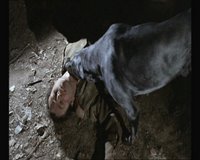 He opens one and finds a wrapped shape with a stake in it and so pulls the stake (as you do! Actually for a real good look at whether you would pull the stake out or not I’d suggest the book "The Stake" by Richard Laymon, however in this case the soldier was just plain stupid). The shape below the sackcloth seems to move then a black dog leaps at him and bites his neck. Zoltan is awake.
He opens one and finds a wrapped shape with a stake in it and so pulls the stake (as you do! Actually for a real good look at whether you would pull the stake out or not I’d suggest the book "The Stake" by Richard Laymon, however in this case the soldier was just plain stupid). The shape below the sackcloth seems to move then a black dog leaps at him and bites his neck. Zoltan is awake.
Zoltan jumps up and paws at an unopened tomb, belonging to Count Igor Dracula (Michael Pataki), and remembers back to when he was just a mortal pooch and sensed something nearby. 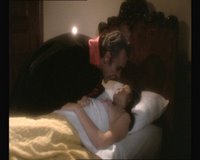 In a nearby room Dracula is approaching a sleeping victim but the dog's barks awaken the woman and she screams. Dracula flees, turns into a bat and suckles upon the dog instead. This, and a further memory sequence, is the only *real* vampiric action we get. Unfortunately it is a dog's memory, a dog who remembers events it did not see (ie Dracula in the room - but perhaps, to be really generous, Zoltan picked those memories up from Dracula) and it is a scene that is completely lacking in atmosphere.
In a nearby room Dracula is approaching a sleeping victim but the dog's barks awaken the woman and she screams. Dracula flees, turns into a bat and suckles upon the dog instead. This, and a further memory sequence, is the only *real* vampiric action we get. Unfortunately it is a dog's memory, a dog who remembers events it did not see (ie Dracula in the room - but perhaps, to be really generous, Zoltan picked those memories up from Dracula) and it is a scene that is completely lacking in atmosphere.
Zoltan 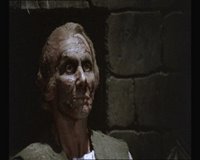 pulls a coffin out, knocks the lid off and reveals a staked skeleton. He pulls the stake and Veidt Smit (Reggie Nalder) reforms, looking a tad worse for wear. Telepathically he tells Zoltan that they must find a new master. As they leave the crypt a further earth tremor causes the crypt to become sealed.
pulls a coffin out, knocks the lid off and reveals a staked skeleton. He pulls the stake and Veidt Smit (Reggie Nalder) reforms, looking a tad worse for wear. Telepathically he tells Zoltan that they must find a new master. As they leave the crypt a further earth tremor causes the crypt to become sealed.
The next day the soldiers have obviously re-excavated the crypt and have pulled the coffins up out of the earth. Maj. Hessel (Arlene Martel) and Inspector Branco (José Ferrer) have a coffin opened and find a staked corpse. Definitely a vampire tomb, decides Branco. They check the guard who was attacked by Zoltan and he has a faint pulse but no discernable breathing. They have the coffins and bodies burnt, stake the guard and have him burnt too. They are left with the quandary of two empty coffins.
Branco has done some research and realised that one of the coffins contained Smit and here we have some interesting genre lore, as far as I can tell solely emanating from this film and the novellisation by Ken Johnson. Smit is a “fractional lamia”. Essentially he is an immortal who can only be killed by stake but can function in daylight and has no bloodlust, however he cannot survive without a vampire master. It is clear to Branco that he will be looking for the last remaining Dracula, sent away for his own safety when a child. That person is one Michael Drake (Michael Pataki again) and Branco tells Hessel where he lives in LA, the exact address, Hessel arranges to get a visa but it might take some time. Little do they know that Smit is in the room listening to the conversation.
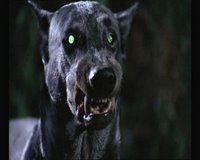 It is obviously easier for a person returned from the grave to get out of the Soviet Union than it is for a government official to get a visa because we see Smit on a ship. He remembers going out to look for his dog, for he was Zoltan’s mortal owner, and finding Dracula who does a little eye mojo and makes Smit his fractional lamia. The ship arrives in LA and Smit and Zoltan go looking for their new master.
It is obviously easier for a person returned from the grave to get out of the Soviet Union than it is for a government official to get a visa because we see Smit on a ship. He remembers going out to look for his dog, for he was Zoltan’s mortal owner, and finding Dracula who does a little eye mojo and makes Smit his fractional lamia. The ship arrives in LA and Smit and Zoltan go looking for their new master.
Mike Drake is married to Marla (Jan Shutan) and they have two kids Linda (Libby Chase) and Steve (John Levin). They are about to go camping for two weeks and decide to take their two German Shepherds, Annie and Samson, plus the two unnamed puppies. Zoltan does go to the house that night but Samson’s barking wakes the household, causing Zotan to back off, the next day the family go on their camping trip, followed by a black hearse (driven by Smit and containing Zoltan’s doggy coffin). Before they leave Mike finds some old family photos including one of Igor Dracula with Zoltan – so vampires can be photographed in this.
The next section of the film sees the family’s trip falling apart. Firstly they lose a puppy that strands itself in a moored rowboat and becomes Zoltan fodder. Then Zoltan gets to the camper but is chased off by Samson. Mike saw Zoltan briefly and thinks it looked like a wolf, which means that Mike Drake has no idea what a wolf looks like! When, the next day, they find the puppy they assume death by exposure but as they bury it Mike notices the fang marks and assumes a rattler got it. T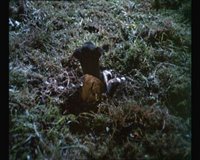 his leads to the *terrifying* scene of the puppy rising from the grave, honestly you have to watch a puppy rise from the grave to realise how none threatening it seems.
his leads to the *terrifying* scene of the puppy rising from the grave, honestly you have to watch a puppy rise from the grave to realise how none threatening it seems.
Zoltan gets a pair of fishermen’s dog and bites its neck (only a neck bite will change you into one of the undead it seems) and then the dogs try and invade the camper. Mike is attacked but they run off, unbeknown to him because they see his crucifix. Then, the next night, they vampirise Annie and Samson runs off into the night. It also becomes apparent that the vamped dogs turn a charcoal grey colour. Having lost their dogs and suffered several dog attacks Mike, sensibly, decides to get out of there. Then Branco arrives. He explains to Mike what is going on (with the amusing aside from Mike that if it is true he is going to sue the movie companies making Dracula pictures without his permission). Despite not being convinced he sends his family away and goes off to a fisherman’s cabin with Branco.
That night they suffer the siege of the vampire dogs, which generally make a mess of the cabin. Branco has put two and two together and seems to realise that it was a dog in the second coffin so they head back to the original campsite. Now the only reason I can see for going off to the cabin and then back to the campsite was that they were so distant it took out the daylight hours and the filmmakers couldn’t work out what to do with the characters during the day!
Reaching the campsite they split up. Branco finds Smit, fights him and then stakes him. 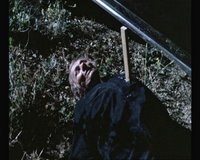 Mike is attacked by the vampire dog pack and hides in the soft-top convertible that the dogs seem to have trouble getting into! He eventually starts the engine (having recognised Annie as one of the dogs and Zoltan from its picture), drives off and then sees Samson running up. He lets Samson into the car who is, of course, a vampire. A bit of a struggle and he stakes the dog. Meanwhile the fishermen are tackling two of the dogs and Branco appears to stake them. Mike chases Zoltan, gets hypnotised by the pooch's vampire eyes and drops his stake and bears his chest. This reveals the cross which causes the dog to back off and fall off a cliff onto a fence that stakes the erstwhile Devil dog!
Mike is attacked by the vampire dog pack and hides in the soft-top convertible that the dogs seem to have trouble getting into! He eventually starts the engine (having recognised Annie as one of the dogs and Zoltan from its picture), drives off and then sees Samson running up. He lets Samson into the car who is, of course, a vampire. A bit of a struggle and he stakes the dog. Meanwhile the fishermen are tackling two of the dogs and Branco appears to stake them. Mike chases Zoltan, gets hypnotised by the pooch's vampire eyes and drops his stake and bears his chest. This reveals the cross which causes the dog to back off and fall off a cliff onto a fence that stakes the erstwhile Devil dog!
It is all over, but wait we have the epilogue twist as the camera pulls away, follows a trail of ripped up birds and animals to the terrifying sight of the vampire puppy!
The acting is below average throughout. Nalder only speaks in the memory sequences and his dialogue in the rest of the film is voice-over telepathy. The concept is poor and the soundtrack consists of seventies synthesisers (including a Bontempi by the sound of things) that produce an obtrusive and none atmospheric mess.
This is one that is so bad it has to be seen to be believed. I’m giving a score of 1.5 out of 10, and those points are mainly given for the idea of the fractional lamia which, despite a silly name, was an interesting concept for a Renfield type servant.
The imdb page is here.
Many thanks to Zombiepunk who found the Horror Classics DVD set for me.
Posted by
Taliesin_ttlg
at
7:39 AM
5
comments
![]()
Labels: Dracula, undead, vampire, vampire dog
Monday, August 28, 2006
The Vampire Speaks
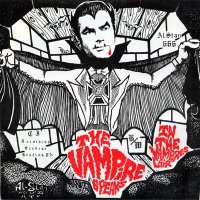 Nip on over to Scar Stuff, if you fancy getting hold of Al Zanino’s “The Vampire Speaks in the Vampire’s Lair". 6 Minutes of weirdness…
Nip on over to Scar Stuff, if you fancy getting hold of Al Zanino’s “The Vampire Speaks in the Vampire’s Lair". 6 Minutes of weirdness…
Scar Stuff is a great site and well worth an exploration.
Posted by
Taliesin_ttlg
at
1:07 AM
0
comments
![]()
Sunday, August 27, 2006
Interview With the Vampire - review
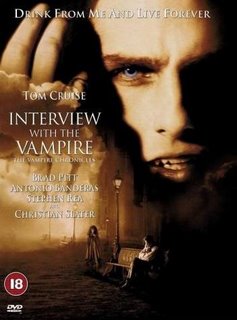 Director: Neil Jordan
Director: Neil Jordan
Release Date: 1994
Contains spoilers
The problem with Interview With the Vampire, The Vampire Chronicles, is knowing where to start. The series of books by Anne Rice are a phenomena in their own right and this is probably one of the most popular vampire films produced. It does deviate from the book, not only by missing some areas (of story and character development) out – which given the length of the book was always going to be a given – but by changing some minor aspects. All in all, however, it is a fairly accurate translation of the book.
It begins with Louis de Pointe du Lac (Brad Pitt) in a hotel room with an interviewer (Christian Slater). Louis was going to feed on the interviewer, in an alleyway before the film begins, until he spoke. The interviewer is a collector of lives, finding interesting people and asking them to recount their life stories for him. When he asks Louis what he does, it is clear he could never have expected the answer “I am a vampire.” Louis puts on the light and then moves, with a speed unmatchable by a mere mortal, back to the table. In the light it is clear that Louis is something unnatural. His skin is a deathly pallor, vivid blue veins visible beneath the skin. His nails are long and glossy and his eyes shine with a luminescence born of the supernatural. The look the vampires are given is well done, unusual enough that we can see they are something else, yet we could also believe that they could pass for normal in society.
The interviewer is obviously convinced and Louis begins his tale in 1791. He was 24 and master of a plantation. His wife and child had died six months before, a departure from the book as it was his brother who had died in that, and Louis was so filled with grief that he became out of control. He whored, gambled and generally put his life on the line. In his own words the invitation to death “Was open to anyone. To the whore at my side. To the pimp that followed. But it was a vampire that accepted.”
Louis is robbed by the pimp 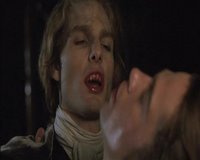 and suddenly the whore and pimp are killed. He is picked up by the vampire, Lestat de Lioncourt (Tom Cruise), and bitten. This is where we depart from the book again (and the rules it established), and a section that, whilst it looked flash I am not too sure about. Lestat flies into the air with Louis as he bites. In the books the power of flight was only attained by the most ancient vampires (and those who drank from the ancients). One might say that Lestat is lifting Louis above the dross of humanity and yet it seems a scene there for effect only.
and suddenly the whore and pimp are killed. He is picked up by the vampire, Lestat de Lioncourt (Tom Cruise), and bitten. This is where we depart from the book again (and the rules it established), and a section that, whilst it looked flash I am not too sure about. Lestat flies into the air with Louis as he bites. In the books the power of flight was only attained by the most ancient vampires (and those who drank from the ancients). One might say that Lestat is lifting Louis above the dross of humanity and yet it seems a scene there for effect only.
The next night Lestat visits an ill looking Louis and offers him “the choice I never had”. Louis watches his last sunrise and Lestat comes again. He drains Louis to the point of death and then gives him the choice. Drink of his blood or die. Louis chooses to drink, he goes through a painful mortal death and then opens his eyes as a vampire. We see the world through his eyes, a statue that seems to open its eyes shows us this but, as he informs the interviewer, no mortal could ever know what it was like. We also learn some of the vampiric rules. Crucifixes are not effective, nor is a stake through the heart. Coffins and blood are a necessity. Later we discover that vampires can drink animal blood, though, as Lestat informs us, “I wouldn’t call it living, I’d call it survival.” Fire and sunlight are effective. Beheading also.
There is also the interesting idea that a vampire will only drain to the point of death, lest the dying mortal kill the vampire by drawing them into the death. This suggests that the act of feeding is very much an intimate one that makes a connection between the vampire and victim. We also discover that the blood of the dead must not be drunk by a vampire. Finally the various vampires receive gifts, Lestat can read minds though it is not an ability that Louis enjoys. I really don’t want to go through the plot point by point as I would be here for quite a while but there are some major plot points that we need to investigate.
The next section of the film follows Louis and Lestat’s time together, whilst Louis remains at odds with his vampiric nature. 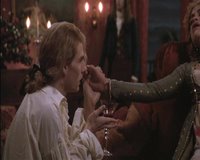 We see now two very different vampires. Louis does not wish to kill and Lestat is a brutal killer gorging on two or three victims per night. Lestat is also a sadist, enjoying playing wicked games with his victims. When asked why he does this he states “I like to do it. I enjoy it.”
We see now two very different vampires. Louis does not wish to kill and Lestat is a brutal killer gorging on two or three victims per night. Lestat is also a sadist, enjoying playing wicked games with his victims. When asked why he does this he states “I like to do it. I enjoy it.”
Louis is filled with guilt and thus does not wish to kill to survive. Lestat comments upon this when he says, “Merciful death. How you love your precious guilt.” Instead Louis feeds upon the blood of animals and, when he slips, he becomes enraged at himself. We see this when he attacks his slave and housekeeper, Yvette (Thandie Newton), following which he burns his grand home to the ground and is rescued from the conflagration by Lestat.
The temptation, of course, is always going to be there as only drinking from a human will give him any form of peace. Eventually he slips once more and attacks a young child, Claudia (Kirsten Dunst), who is by her plague killed mother’s side.
This brings us to the next section of the movie. Lestat finds Louis and brings him home. 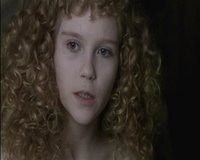 Claudia is not yet dead and Lestat threatens to turn her. Louis wants to stop him but his own guilt gets in the way, it is the only way that she will survive. Lestat’s motivation seems simple, when he explains to Claudia “You see, Louis was going to leave us, he was going to go away, but now he's not. Now, he's going to stay and make you happy.” This is the master manipulator but these characters are not one dimensional and Louis suspects there were more complex, individual reasons for his actions.
Claudia is not yet dead and Lestat threatens to turn her. Louis wants to stop him but his own guilt gets in the way, it is the only way that she will survive. Lestat’s motivation seems simple, when he explains to Claudia “You see, Louis was going to leave us, he was going to go away, but now he's not. Now, he's going to stay and make you happy.” This is the master manipulator but these characters are not one dimensional and Louis suspects there were more complex, individual reasons for his actions.
Claudia’s turning is strange in that when she turns her hair suddenly develops ringlets; to be honest I could not see why that would occur, though they do prove a plot-point later. From the first she is a ruthless killer and her presence seems to make Louis more at ease with his own nature as a predator.
The three live together as a family for thirty years, but it is a relationship doomed. Claudia becomes obsessed with the fact that she is forever trapped within a child’s body, to the point of killing a mature woman she wants to be and hiding her rotting corpse in the house (raising the question of why neither Louis or Lestat smelt the corpse, after all Louis later states that he can smell death). This turn of events is probably not helped by Lestat who still treats her as a child. It is unlikely that the maturity she seeks is a sexual maturity; whilst not explicit in the film the books explain that the vampires have no sexual drive. Rather it is about change for its own sake, about evolution which is the major thrust of the movie and shall be discussed later.
Claudia tries to cut away her doll-like locks and they immediately grow back. She is unchanging and she blames Lestat. To avenge herself, and free herself and Louis from Lestat, she feeds Lestat from boys she has killed with Laudanum, keeping the blood warm and giving the appearance that they have passed out. She then slits Lestat’s throat and she and Louis dump him in the swamps. Louis and Claudia book passage to Europe but Lestat returns, looking worse for wear and rather angry. In their bid to escape Louis throws an oil lamp at Lestat, setting him alight and causing a blaze that rips through the city.
she feeds Lestat from boys she has killed with Laudanum, keeping the blood warm and giving the appearance that they have passed out. She then slits Lestat’s throat and she and Louis dump him in the swamps. Louis and Claudia book passage to Europe but Lestat returns, looking worse for wear and rather angry. In their bid to escape Louis throws an oil lamp at Lestat, setting him alight and causing a blaze that rips through the city.
The next stage of the film sees the two vampires in Paris. They have searched Europe for more of their own kind and failed but in Paris vampires find them. The vampires in Paris live in catacombs below a theatre – the Théatre des Vampires. In the theatre the vampires pretend to be humans pretending to be vampires (“How avant-garde.” Remarks Claudia). The show seems to culminate with the vampires killing and feasting on a victim with the audience tricked into believing it to be part of the show.
 The leader of these vampires is Armand (Antonio Banderas). Whilst his performance is excellent I must admit to being slightly unhappy with the casting as Armand is emblazoned in my mind, from the books, as a golden haired youth – that is somewhat petty however. Armand allows us to know the real crux of the vampire problem. He is the oldest, that he is aware of, vampire. Most vampires do not have the stomach for immortality, the world changes around them and they remain the same. It is the key to the whole piece, a failure to evolve is the undoing of immortality. Armand wants Louis to be his guide to the new era.
The leader of these vampires is Armand (Antonio Banderas). Whilst his performance is excellent I must admit to being slightly unhappy with the casting as Armand is emblazoned in my mind, from the books, as a golden haired youth – that is somewhat petty however. Armand allows us to know the real crux of the vampire problem. He is the oldest, that he is aware of, vampire. Most vampires do not have the stomach for immortality, the world changes around them and they remain the same. It is the key to the whole piece, a failure to evolve is the undoing of immortality. Armand wants Louis to be his guide to the new era.
We discover that there is a belief that children should not be turned and that the one vampire crime is to kill another vampire. This puts Claudia in danger but, in truth, it probably has more to do with Armand wishing to sever Louis’ ties to her, to make Louis be with him. Claudia senses this and finds Madeleine (Domiziana Giordano), a woman who has lost her child, to be her new companion. However she needs Louis to turn her as she doesn’t have the strength in her small frame. Louis does this but feels that, as Madeleine dies, 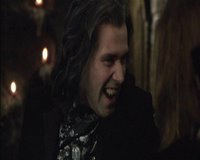 “What has died is the last breath in me that was human.”
“What has died is the last breath in me that was human.”
Madeleine’s tenure as a vampire is short lived. The vampires from the theatre, led by Santiago (Stephen Rea), take the three. They bury Louis alive and then put Claudia and Madeleine into a well to be killed by the sun. Louis is rescued by Armand, though he waits until Claudia has perished. Louis gets his revenge by destroying the whole coven, setting them alight in their coffins and finishing the others off by scythe. 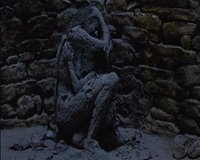 Out of the burning theatre he is caught by the rising sun but is rescued by Armand, however he can see Armand’s hand in the events and refuses his companionship.
Out of the burning theatre he is caught by the rising sun but is rescued by Armand, however he can see Armand’s hand in the events and refuses his companionship.
The final section of the film is a series of codas that witness Louis through the ages, represented often by cinema. In 1988 he finds Lestat again, a broken wretch scared by the searchlights from helicopters but refuses to stay with him. The interviewer is despondent, the story cannot end like that and offers himself as a companion for Louis but the interviewer has not understood. He shows the interviewer his true, enraged face and then leaves. Running to his car, the interviewer reviews the tapes when Lestat rises from the back seat and attacks, offering the interviewer a choice he never had.
Minor plot and casting quibbles aside, and they are very minor; this is a glorious and sumptuous film. Direction and cinematography are beautiful as is Elliot Goldenthal’s score. Brad Pitt makes Louis seem sympathetic, despite his maudlin nature. That said the film is peppered with stars and all performances are strong but two stand out.
Anne Rice was not happy with the casting of Cruise as Lestat and publicly said so, at the time I agreed. Yet when she had seen the film she openly apologised and the reason is obvious, this is a fine performance by Cruise who takes Lestat and makes the character his own.
However top praise must go to Kirsten Dunst, still a child actor at the time, whose performance as Claudia is faultless, carrying a maturity in her acting that belies her youth. It would have been too easy to cast a child actor who would have spoilt the film, Dunst's presence is as strong as the adults involved.
This is a stunning film and a must for all fans of the genre. It carries a slight weight of the melodramatic perhaps, but this is balanced by the low-key humour that peppers the film, from Lestat dancing with the corpse of Claudia’s mother (“There's still life in the old lady yet.”) to some of the vaudeville performances in the theatre.
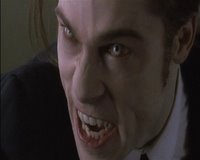 I am going to give Interview with the Vampire 10 out of 10, I considered a point lower but felt that I was letting my own expectations from the book cloud, ever so slightly, a masterpiece of vampire cinema. I guess, however, that I must confess to being a fan of Neil Jordan's work anyway.
I am going to give Interview with the Vampire 10 out of 10, I considered a point lower but felt that I was letting my own expectations from the book cloud, ever so slightly, a masterpiece of vampire cinema. I guess, however, that I must confess to being a fan of Neil Jordan's work anyway.
The imdb page is here.
I am going to give the last word to Lestat, “Oh Louis, Louis. Still whining Louis.”
Posted by
Taliesin_ttlg
at
2:41 AM
7
comments
![]()
Friday, August 25, 2006
The Vampire Happening – review
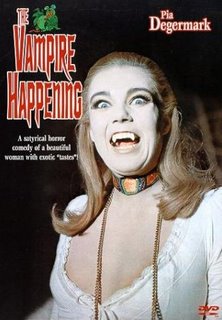 Directed by: Freddie Francis
Directed by: Freddie Francis
Release Date: 1971
Contains spoilers
This film had the aim, it seems, not to scare but to amuse and to titillate. After all how many serious vampire movies are going to feature a cuckoo clock with a skull in it (okay there probably are serious films with that) and a heroine who doesn’t believe in vampires yet drives a car with the number plate “VM-1PR”? As for the titillation, well the heroine spends an awful amount of time either wearing very slinky dresses or in various states of undress.
The film begins with said heroine, Betty Williams (Pia Degermark), arriving at a castle. She is an American actress and the castle has been left to her by her uncle.
The butler, Josef (Ivor Murillo), is shocked at her arrival as she is the very image of Clarimonde Catani, Betty’s Great Grandmother who is also played by Degermark. The main difference between the two is that Clarimonde was brunette and Betty is blonde. Clarimonde was somewhat of a scarlet woman in her time and then was found dead, naked with two teeth marks on her neck. The official explanation was that she was killed by a rabid fox, but many believe she was killed by a vampire.
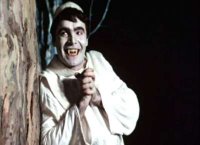 Betty decides to seduce a local monk, Martin (Joachim Kemmer), and when she meets him she is wearing a brunette wig. She invites him to the castle but before he arrives opens up Clarimonde’s locked coffin, in which Clarimonde is perfectly preserved. Martin becomes the vampire’s first victim – official cause of death bitten by a rabid fox (incidentally I mentioned the brunette wig as this explains why Martin believed the brunette vampire was Betty).
Betty decides to seduce a local monk, Martin (Joachim Kemmer), and when she meets him she is wearing a brunette wig. She invites him to the castle but before he arrives opens up Clarimonde’s locked coffin, in which Clarimonde is perfectly preserved. Martin becomes the vampire’s first victim – official cause of death bitten by a rabid fox (incidentally I mentioned the brunette wig as this explains why Martin believed the brunette vampire was Betty).
The rest of the film is a series of mistaken identity between the vampire and her great granddaughter, both wearing different coloured wigs, with a mighty large slice of bedroom farce involving school teacher Larsen (Thomas Hunter) who has become Betty’s lover.
We also have comedy moments with Josef trying to slay the vampire, in a performance that comes across as a sub-Professor Abronsius from “The Fearless Vampire Killers” (1967) and a brief vampire rising and hunting comedy moment with Martin.
The trouble is, the comedy just isn’t funny. As an example, in a line that the Carry On producers would have rejected, Betty asks Larsen “What if I turned out to be a vampire?” Larsen grabs her and quips “Then I’d drive my stake into you, you little devil.”
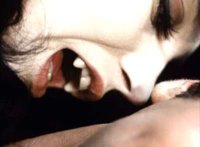 The vampire rules are fairly standard. Stake through the heart and sunlight are deadly. A silver cross or garlic repels. Throwing into a deep lake is also a solution.
The vampire rules are fairly standard. Stake through the heart and sunlight are deadly. A silver cross or garlic repels. Throwing into a deep lake is also a solution.
At one point Josef hunts Clarimonde whilst wearing the helmet from a suit of armour, thus affording neck protection. Clarimonde still tries, and fails, to bite the butler. I also noticed that Clarimonde had extensive fillings in her teeth, during a close up bite shot, and found the idea somewhat anachronistic.
The film takes a turn to the bizarre when Betty goes to a party at a nearby castle, with Clarimonde hitching a ride in the boot as the party is a convention for vampires. This entire portion of the film is another rip-off of “The Fearless Vampire Killers” with Larsen and Josef disguising themselves to infiltrate and rescue Betty.
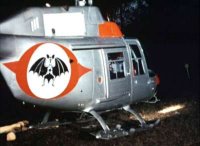 I say it is bizarre as it features the guest of honour, Dracula, who arrives by helicopter, piloted by a vampire gangster, that has a bat emblazoned on the side. Dracula, whose motto is “death to the living”, was Clarimonde’s lover and questions her about her having the worst kind of sex, “Human sex.” Clarimonde simply states that it is better than bloodsucking.
I say it is bizarre as it features the guest of honour, Dracula, who arrives by helicopter, piloted by a vampire gangster, that has a bat emblazoned on the side. Dracula, whose motto is “death to the living”, was Clarimonde’s lover and questions her about her having the worst kind of sex, “Human sex.” Clarimonde simply states that it is better than bloodsucking.
In order that they might save Betty, Josef is instructed by Larsen to put the main castle clock back. Thus the vampires will get caught out by the sun. It is actually Clarimonde who rescues her Great Granddaughter, because she is family. In another case of mistaken identity the men think that Betty has been vampirised and, rather than stake her, they ship her (or should I say Clairmonde) home to LA.
It is here that the film ends, having raised nary a titter. The film is bizarre but very unfunny and I’m only going to give it 2 out of 10. However, you can find out for yourself as the Count Gore De Vol introduced version is available for free download from the archive.
The imdb page is here.
Posted by
Taliesin_ttlg
at
7:39 AM
0
comments
![]()
Thursday, August 24, 2006
Music: Carfax Abbey
 This US goth band have more than a touch of vampiric overtones. The band name, obviously, has a direct connection to Dracula .
This US goth band have more than a touch of vampiric overtones. The band name, obviously, has a direct connection to Dracula .
They have recorded a track called “The World will Have to Wait” which begins with a chant of “vampirism”. They had a track named “Soul to Bleed” that was featured on the compilation CD “Music form the Succubus Club”. The CD is full of tracks inspired by the role playing game “Vampire: The Masquerade” and Carfax Abbey’s song is inspired by clan Malkavian. Last, but not least, they have recorded a fine cover of “Cry Little Sister”, the theme to the Lost Boys.
All three tracks, plus six others, can be heard in streaming format at their homepage.
Posted by
Taliesin_ttlg
at
8:28 AM
0
comments
![]()
Wednesday, August 23, 2006
Short Film: Love Bites
 I found this short film on ifilm and thought I’d share. Love Bites story goes a little like this, after a hot date a man awakens to discover he has no reflection. But how is he to cope when he can’t go out in the sun?
I found this short film on ifilm and thought I’d share. Love Bites story goes a little like this, after a hot date a man awakens to discover he has no reflection. But how is he to cope when he can’t go out in the sun?
This little film won the DV Challenge #5 online film competition and has some excellent mirror tricks. Well worth a watch.
Posted by
Taliesin_ttlg
at
8:09 AM
0
comments
![]()
Tuesday, August 22, 2006
Last Exit for the Lost
 Now this caught my attention, not just because it is a vampire movie, but also because it is the title to a Fields of the Nephilim track.
Now this caught my attention, not just because it is a vampire movie, but also because it is the title to a Fields of the Nephilim track.
Last Exit for the Lost is a vampire movie available for free download from Blue Dog Films and you’ve gotta love free vampiric goodies.
The download is some 147 Meg, so 56kers beware, and the film runs for 42:28.
A film about a pair of vampire hunters, Loki and Nathaniel, renegades uneasily employed by the church as they search for the vampire who took Loki’s wife. This is a great short, well put together with an excellent soundtrack by The difference engine.
Still need convincing, then watch the teaser trailer:
Posted by
Taliesin_ttlg
at
3:38 AM
0
comments
![]()
BBC’s Dracula news
 Burnham-on-sea.com have released exclusive pictures of the filming of Dracula. Nip over there to get some eye-candy. Looking at the pictures we can assume that the wreck of the Demeter will form part of this new version.
Burnham-on-sea.com have released exclusive pictures of the filming of Dracula. Nip over there to get some eye-candy. Looking at the pictures we can assume that the wreck of the Demeter will form part of this new version.
Cast news shows the following actors involved:
Dracula: Marc Warren
Holmwood: Dan Stevens
Lucy: Sophia Miles
Seward: Tom Burke
Harker: Rafe Spall
Mina: Stephanie Leonidas
Van Helsing: David Suchet
Posted by
Taliesin_ttlg
at
12:55 AM
0
comments
![]()
Monday, August 21, 2006
Blood for Dracula - review
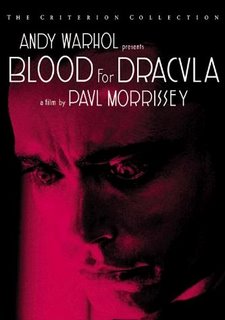 Director: Paul Morrissey
Director: Paul Morrissey
Release Date: 1974
Contains Spoilers
Produced by Andy Warhol, this oddity is a little difficult to fathom. As a serious piece of cinema it falls flat through some atrocious acting and yet it has a streak of black humour which makes it very watchable and some highly unusual precepts that make it rather unusual in the genre as a whole.
Udo Kier plays Dracula and when we first see him he is applying makeup and painting his hair to make his albino looks more acceptable to the world. His skill must be exceptional as, when the camera pans around, we realise he casts no reflection and he does all this by touch and through experience. His secretary, Anton (Arno Juerging), enters the room with the Count’s ailing sister and tells the Count that he must leave Romania. The Dracula line is dying as they can only ingest virgin blood, the Count must leave and find a virgin bride. Anton suggests Italy as the strength of the Roman Catholic 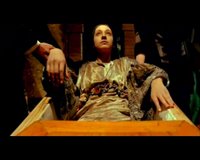 Church means that virgins will be found aplenty. They discuss the trip, the count wishing to take dried flowers and his stuffed birds and concerned about how Anton’s car will cope with his coffin (they tie it to the roof). Before leaving they help the Count’s sister into the crypt and place her in her coffin.
Church means that virgins will be found aplenty. They discuss the trip, the count wishing to take dried flowers and his stuffed birds and concerned about how Anton’s car will cope with his coffin (they tie it to the roof). Before leaving they help the Count’s sister into the crypt and place her in her coffin.
It is within the character of Dracula that we find a very different vampire; he is ailing, dying even. He spends much of his time in a wheelchair and suffers convulsive spasms. He is able to enter sunlight, simply holding his hat up to ward off the direct sun and touch holy items, though they cause him much distaste. The biggest change however is that he can only drink virgin blood and, bizarrely, this makes him almost a moral compass.
We see the Di Fiore family, and it is to these that the Count goes to in order that he might find his new bride. At first we see the eldest sister, Esmeralda (Milena Vukotic), and her mother (Maxime McKendry). Working the garden are the other three sisters, Saphiria (Dominique Darrel), Rubinia (Stefania Casini) and fourteen year old Perla (Silvia Dionisio). Saphiria complains that it is too hot and removes her top, followed by Rubinia. This is too much for Perla and her protest brings the girls’ nudity to the attention of their mother.
The estate has fallen on hard times due to the gambling of the father (Vittorio De Sica) and the mother sees the arrival of the Count, looking for a bride, as a way out of their dire straits. More than this she realises that, due to his ill-health, whichever daughter marries him will likely be a rich widow soon. Of course the Count insists on virginity or a wirgin as Anton pronounces it and it is here that things go wrong.
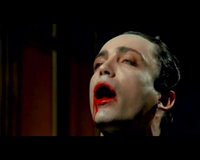 The best matches are likely to be Saphiria or Rubinia, but these girls are far from virginal. Both are having regular sex, including incestual pairings together, with the handyman Mario (Joe Dallesandro). A word about Mario as he is the ‘hero’ of the piece. Firstly his New York drawl seems very out of place, especially as he is a second generation servant of the estate. He is obsessed with the Russian Revolution and the overthrow of the aristocracy – even painting a hammer and sickle on the wall of his shack. Yet he is entirely without morals, talking openly to the two sisters he sleeps with about his desire to rape their youngest sister, forcing sex on a protesting Saphiria, beating Rubinia. He is a thoroughly dislikeable character.
The best matches are likely to be Saphiria or Rubinia, but these girls are far from virginal. Both are having regular sex, including incestual pairings together, with the handyman Mario (Joe Dallesandro). A word about Mario as he is the ‘hero’ of the piece. Firstly his New York drawl seems very out of place, especially as he is a second generation servant of the estate. He is obsessed with the Russian Revolution and the overthrow of the aristocracy – even painting a hammer and sickle on the wall of his shack. Yet he is entirely without morals, talking openly to the two sisters he sleeps with about his desire to rape their youngest sister, forcing sex on a protesting Saphiria, beating Rubinia. He is a thoroughly dislikeable character.
Dracula tries his luck with Saphiria first, trying to cajole her into admitting she is not a virgin. When she does not admit this he bites her and drinks, but then vomits the blood back up in a protracted and convincingly painful looking scene. The next day she informs her mother that she was not wanted as she was not a virgin and her mother cannot believe that she admitted such a thing. Saphiria seems pale (having lost a lot of blood) and is entirely unwilling to discuss her time with the Count.
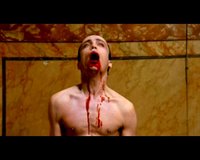 The next sister he meets with is Rubinia and again he tries to cajole the truth of her virginity. Whilst they talk she realises that he has no reflection and tries to run, but he grabs and bites her, again vomiting blood afterwards. “The blood of these whores is killing me!” He exclaims.
The next sister he meets with is Rubinia and again he tries to cajole the truth of her virginity. Whilst they talk she realises that he has no reflection and tries to run, but he grabs and bites her, again vomiting blood afterwards. “The blood of these whores is killing me!” He exclaims.
Anton has decided that they should leave but the Count visits Esmeralda, leaving her alone when he hears that she was once engaged, thus assuming that she 'knew' her fiancé. However things are now coming to a head. Dracula’s coffin has been kept in the family chapel and Mario opens it, finding it empty.
Rubinia and Saphiria, now under Dracula’s control, go to Perla and check her virginity before dragging her to the Count. She escapes and runs straight into Mario who rapes her in order to “protect her”, he has realised (by seeing an empty coffin!) what the Count really is. The mother enters at this point and he drags them both to see the two bitten sisters and what they have become.
We see the Count enter and drop to the floor to lap the blood of Perla’s lost virginity from the floor and then we see Esmeralda walk in.
Mario gets an axe in order to kill Dracula, smashing the coffin that Dracula and Anton are attempting to remove. Anton is ultimately shot by the mother after stabbing her and the chase is now on, towards probably the most bizarre death of Dracula in a movie. 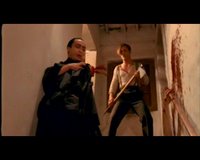 Mario chases Dracula through the house, managing to chop an arm off that stays attached to the rail he held. Out of the house he takes the second arm and then chops a leg of. Dracula, now on the floor, looses his last leg whilst insisting that Mario cannot hurt him. I couldn’t watch this scene without thinking of Monty Python (interestingly the film I’m thinking of was released the following year).
Mario chases Dracula through the house, managing to chop an arm off that stays attached to the rail he held. Out of the house he takes the second arm and then chops a leg of. Dracula, now on the floor, looses his last leg whilst insisting that Mario cannot hurt him. I couldn’t watch this scene without thinking of Monty Python (interestingly the film I’m thinking of was released the following year).
Mario is about to stake him when Esmeralda throws herself over his body, screaming for Mario to stop as he is hers and we see the glint of fangs in her mouth. It is now clear that she was a virgin and has offered herself willingly to Dracula. She is pulled away and he is staked, so she throws herself onto the stake also.
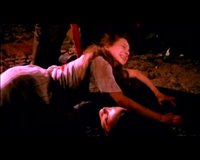 It is a strange ending to a strange movie. None of the acting is particularly good, at best it comes across as very stagey and at its worst (Arno Juerging’s acting for example) it is just plain awful. The best acting, as you would expect, comes from Kier whose performance, whilst drifting to pantomimish at times, does offer us a sympathetic figure.
It is a strange ending to a strange movie. None of the acting is particularly good, at best it comes across as very stagey and at its worst (Arno Juerging’s acting for example) it is just plain awful. The best acting, as you would expect, comes from Kier whose performance, whilst drifting to pantomimish at times, does offer us a sympathetic figure.
The film contains a good bit of gore, copious blood vomiting and chopped limbs, and a high level of nudity with strong sexual themes. It is within the nudity and some of the sexual taboos that the film touches on that the real puzzle of the movie is revealed. The mortals are, in the main, despicable. The mother is entirely mercenary, the father a gambling fool who puts stock in how names ‘taste’, Mario is a rapist, including the rape of a fourteen year old, and misogynist, and the two middle sisters are incestuous, users and liars. Dracula is ailing and yet pure. He searches for purity in his proposed bride, he is a vegetarian as he can only eat virgin meat (again unusual within the genre is the idea that the vampire can eat mortal food, but that the meat - like the blood he needs - must be virginal), he clearly loves his sister and talks of his first wife with genuine affection. His bite certainly did not kill the sisters, though it clearly turned Esmeralda as she was a virgin (thus only virgins become vampires).
Normally the vampire is portrayed as the immoral one and yet the film desperately tries to aim all our sympathy at the vampire. It is also clear that there was a simile being drawn between the Count and Warhol, given that the Count is albino. This isn’t a result of his failing body, after all his dying sister looks naturally dark haired. The aversion to direct sunlight possibly has as much to do with his albino condition as it does with his vampiric one.
As I watched this and wondered how I would score it I felt that the acting, and scripting to be fair, really let the film down to the point it should be scored very low. However, the unusual take on vampirism makes this an interesting watch and the black humour does lift the film. 3 out of 10 might seem harsh to some but I cannot score higher, in fairness. That said genre fans need to see the movie as it is one of the more unusual films the genre has to offer.
The imdb page is here.
Posted by
Taliesin_ttlg
at
3:18 AM
11
comments
![]()
Sunday, August 20, 2006
Taking the cure – screenplay
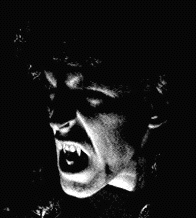 I received a comment yesterday that I feel deserves a post of its own. Some use blogs, as I do, to review or pass on news. Others use blogs to discuss their lives. Charles has used his blog to publish a screenplay, which just so happens to have vampires in it.
I received a comment yesterday that I feel deserves a post of its own. Some use blogs, as I do, to review or pass on news. Others use blogs to discuss their lives. Charles has used his blog to publish a screenplay, which just so happens to have vampires in it.
Admittedly, I have not read it all yet – I have started reading it and do intend to – but I thought that I should point folks over to it.
The screenplay is entitled taking the cure and Charles has pointed out that it is about taking control of our own lives. Thanks Charles for letting me know about this, here’s hoping it gets picked up.
Posted by
Taliesin_ttlg
at
2:25 AM
0
comments
![]()
Sea of Red Vol. 1: No Grave but the Sea - review
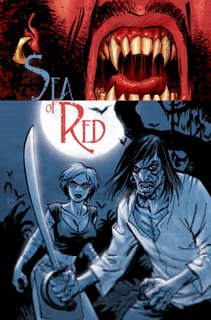 Story & Script: Rick Remender
Story & Script: Rick Remender
Story & Layouts: Kieron Dwyer
Art: Salgood Sam
Released: 2005
Contains Spoilers
Sea of Red is a graphic novel tale of vampires and pirates, recommended to me by regular visitor Mateo.
The graphic follows the tale of Marco Esperanza, and we first meet him at the bottom of the ocean, tied to a figurehead and instinctively catching fish to survive. In the first part we discover what lead to his fate. A victim of a shipwreck he was picked up by corsair captain Lesser Blackthroat. Though not a pirate, and disturbed by some of the things he had seen aboard, he gets drunk with the captain. He tells Blackthroat of his life, and wife and child, before passing out.
When he comes around the ship is deserted, the pirates have boarded a Spanish galleon. He crosses over and sees hideous scenes of carnage. Attacked by a vampire named Canker, he manages to behead the creature but not before the vampire has tasted his flesh. We discover that the vampires rip the hearts from their victims before feeding to stop their return, but Marco is now cursed.
To avenge Canker, Blackthroat ties Marco to the mast of the boarded ship as they scuttle it, promising to visit Marco’s family.
In part two we jump forward to the present day and egomaniac film director Joel Cameron is in a mini sub when they see Marco. Assuming him to be an undecayed corpse they bring him aboard, but Marco immediately launches onto PA Janine, in a haze of hunger. Later we see that Janine turned and has also fed, though her victim has been staked. Cameron wishes to film the story of Marco’s life but the film needs an ending. They discover that Blackthroat had told Marco of an island (in what we now call the Bermuda Triangle) and so set sail to find it.
The vampiric rules are fairly standard, stake through the heart, beheading and sunlight kill the vampires. Injuries are healed through blood, but I did like the idea, when Marco has half his stomach ripped out, that it healed as was, flesh simply fusing together and leaving his torso looking twisted. The vampires can turn to mist, though for reasons unexplained Marco cannot, but rematerialisation hurts and it cannot be repeated immediately. Garlic burns the flesh and holy items are also effective, we see a holy blade, the injuries from which cannot be healed, and a holy water soaked stake was very effective.
As the graphic ends Marco and his companions have just entered the island proper and Cameron is missing.
The artwork is superb; the sepia tones used belying the very gory nature of the illustrations and the characterisation excellent. I can safely say that I’m looking forward to getting part two in the future. 8 out of 10.
Posted by
Taliesin_ttlg
at
1:24 AM
2
comments
![]()
Labels: vampire
Saturday, August 19, 2006
Let’s Scare Jessica to Death - review
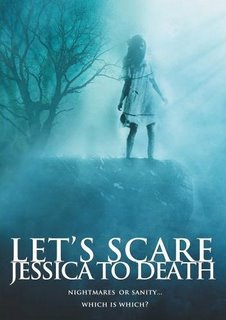 Directed by: John D Hancock
Directed by: John D Hancock
Release Date: 1971
Contains spoilers
A bit of an exclusive as the region 1 DVD of “Let’s Scare Jessica to Death” is due for release on the 28th of this month and yet the online merchant I ordered it from has sent me the copy and it arrived today (the 19th). A quick word about the DVD release, whilst there are no extras to speak of, both the print and sound are excellent, bringing this neglected film to vibrant life.
The film opens with a woman, Jessica (Zohra Lampert), in a rowboat and a voice over. During this we hear the words, “I sit here and I can't believe that it happened. And yet I have to believe it. Dreams or nightmares? Madness or sanity? I don't know which is which.” This quote really sums up the film, as things progress we discover that Jessica had a breakdown following the death of her father and was institutionalised for 6 months. We are never quite sure if what happens to her is real or a product of her own fractured mind and neither is she. This film is a study in sanity desperately trying to clutch onto itself.
We see, what appears to be, a coffin pushed into a hearse and the vehicle pull away. It stops outside the gate of a cemetery and Jessica climbs out of the back. She seems excited and, leaving her husband Duncan (Barton Heyman) and their friend Woody (Kevin O’Connor) in the hearse, she goes to take rubbings of gravestones. In the cemetery she, for a second, spots a blond girl in a white dress (never given a name but played by Gretchen Corbett), then the girl is gone. Jessica’s exuberance vanishes as we hear Jessica’s thoughts “Don’t tell them, act normal.”
Duncan was a concert musician with the philharmonic (the New York one we can assume) but has given that up for Jessica. They are moving from the city to the country, to a house he has bought called the “old Bishop Place”, aiming to work the orchard. They have to cross over by ferry and, as they pass through the nearby town, the locals seem less than friendly.  When they arrive at the large, gothic looking house Jessica leaves the guys to unpack – the “coffin” is actually a cello or bass case we discover. Jessica stands alone and we can hear a voice whispering “Jessica, why have you come here?” She looks to the house and we see a figure in a rocking chair, partially obscured, then the chair is empty. Jessica goes to the door, it is opened, “Don’t tell them” she thinks. In the house she sees legs, at the head of the stairs, running past but Duncan has seen them too.
When they arrive at the large, gothic looking house Jessica leaves the guys to unpack – the “coffin” is actually a cello or bass case we discover. Jessica stands alone and we can hear a voice whispering “Jessica, why have you come here?” She looks to the house and we see a figure in a rocking chair, partially obscured, then the chair is empty. Jessica goes to the door, it is opened, “Don’t tell them” she thinks. In the house she sees legs, at the head of the stairs, running past but Duncan has seen them too.
They find, eventually, Emily (Mariclare Costello) who has been squatting in the house. Jessica invites her to dinner and to stay the night before vacating their property. After dinner the girl plays guitar and sings, Duncan accompanies her but the music takes on a strange timbre and Jessica believes that the plate has blood on it, though again she remains silent. The four try a séance, at Emily’s urging and we hear, though perhaps only Jessica hears with us, a toast being given to the bride, Abigail. It is clear that Woody is attracted to Emily, though it is also clear that Jessica believes that Duncan is too.
The next day the four swim and wash up in the cove behind the house. Jessica notices that as Duncan washes Emily’s neck his hands linger. Emily leaves the cove to prepare lunch and pack and Jessica is swimming alone, the guys are out of the water. We see what appears to be a body in the water touching Jessica and Jessica panics, having to be rescued- when the guys check there is nothing in the water.
After lunch Duncan is preparing things to sell from the house and Jessica finds a portrait of the Bishops. One of the girls in the portrait, Abigail, looks to us very much like Emily, though none of the characters seem to notice (Jessica does later). Having asked Emily to stay, Duncan and Jessica go into town. They are given short shrift by the locals, perhaps to the point of harassment, and Jessica notices that they all wear bandages on necks or arms. They eventually find an antique dealer, recently moved from New York, who is willing to buy their items. He tells them, and us, a little about the Bishops. Of how their daughter Abigail was to be married but drowned in the cove. Of how her body was never recovered and that some say she lives still, a vampire roaming the countryside.
The film becomes more and more intense as it progresses, filmed almost exclusively from Jessica’s point of view. 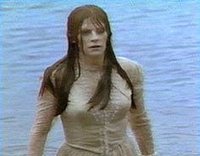 In Jessica’s mind Emily and Abigail are one and the same. The mysterious girl appears occasionally, Duncan is with Jessica when they catch her, but she is mute and can answer no questions (escaping and running when Emily comes near). Jessica comes to believe that she is warning her. When the bandages that the townsfolk wear are removed we see scarring.
In Jessica’s mind Emily and Abigail are one and the same. The mysterious girl appears occasionally, Duncan is with Jessica when they catch her, but she is mute and can answer no questions (escaping and running when Emily comes near). Jessica comes to believe that she is warning her. When the bandages that the townsfolk wear are removed we see scarring.
The joy of the movie is that it leaves much to the imagination, although as the film was shot in the 1970’s we see more than perhaps we would have done if the film had been made earlier. In the main what we get is generated by clever use of sound, half hinted images, whispers in the night (and day) and solid acting by Lampert.
Lampert’s performance cannot be underestimated here. She seamlessly flows between calm and panic, happiness and terror. It is a powerhouse performance and we are never really sure if all that happens is real or in Jessica’s head. Because of this, some of the choices Jessica makes, which in other films may have led the audience to question the scriptwriter, seem natural as Jessica is a woman rapidly loosing touch with reality and desperate to cling to it whatever the cost. I do, however, have to mention the mole – caught by Duncan and kept as a pet by Jessica, it was clearly a mouse, not a mole!
This film is a revelation, too long kept under wraps. Indeed the film keeps much under wraps anyway, refusing to answer questions and leaving mysteries hanging before us. In many ways the vampiric elements are understated, hinted at even and the film has much in common with the more ghost type films such as “The Haunting” (1963). Fans of good, psychologically based horror movies, as well as vampire genre fans searching the more unusual films the genre has to offer, could do much worse than seek this gem out.
8.5 out of 10.
The imdb page is here.
Posted by
Taliesin_ttlg
at
6:20 AM
4
comments
![]()
Labels: vampire, vampiric ghost
Friday, August 18, 2006
Transylvania Twist - review
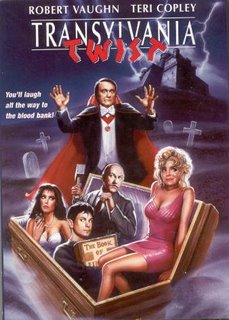 Director: Jim Wynorski
Director: Jim Wynorski
Release Date: 1990
Contains Spoilers
I caught this on Zone Horror and it is a comedy which, whilst it focus heavily on parodying vampire movies also catches several of the more popular horror films of the time. The point is illustrated in the non-plot related prologue where we see a woman, complete with cleavage revealing wench’s top, walking through the woods with a basket. She is followed and we see a pair of legs, then two and then three (number three showing a hint of blood stained apron). The girl begins to run and reaches, what appeared to be, the entrance to a cave that was blocked off. The camera spins round and we see Jason, Freddy and Leatherface are the three who followed her. She rips boards from the entrance and gets in, followed by the monsters. The camera shakes as it remains outside and we here the noise of fighting. The girl appears with knife in hand and bears vampire fangs, she then declares “Amateurs”.
The film proper sees Dexter Ward (Steve Altman), whose name is a Lovecraft reference, attending the funeral of his uncle Ephram (Jay Robinson) who wakes in the coffin, as he wasn’t actually dead. Ephram is the librarian of Arkham University and “accidentally” lent one Marinas Orlock (Howard Morris) the Book of Ulthar, many years before, and has never had it back. Ulthar was a sorcerer who managed to bind the Evil One and the book contains the counter-spell that will release the entity and bring chaos to the world. He has now discovered that Marinas has a daughter, Marissa (Teri Copley), and sends Dexter to see if he can locate her father and bring back the book.
Marissa is a pop star, shooting a video in LA. Unfortunately we have to sit through the whole God-awful faux pop song before the film continues. There is another musical number at the end unfortunately. In a, frankly, un-amusing scene, where the two enter an old sit-com set and so are in black and white and have a laugh track playing against their conversation, we discover that she doesn’t know where her father is, indeed she has never met him. A messenger enters with a telegram from Victor Van Helsing (Ace Mask) informing her that her father has died and she must go to Transylvania for the reading of the will.
The other surviving family member is Lord Byron Orlock (Robert Vaughn) and he is already at the castle, in Lugosi inspired attire, with his three “daughters” - vampire brides of course. When it is clear that Marissa is to inherit everything the race is on to find the book.
There are several vampire scenes worth noting. When we first see Van Helsing it is in a side scene where two striking cemetery attendants break their own picket line to do a spot of body snatching, the body turning out to be that of a vampire. Van Helsing rescues them and stakes the vamp, receiving a copious spray of blood in the face for his trouble. Actually this scene, and another one where a gypsy woman gives Dexter a cross and then demands payment are incredibly similar to scenes from Dracula: Dead and Loving It (1995) but whilst this film did them first, Mel Brooks’ film did them with much more style and panache.
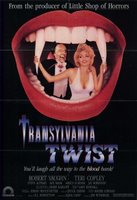 We see scenes of Van Helsing’s childhood also. A Christmas scene, as a moustachioed child, being given the present of stake and mallet. A scene from school where he has mallet and stake removed by the teacher, for slaying a vampire across a school desk, and given lines “I will not stake vampires in class”. Finally we see him as a “young” teen, in a car with a date. He tells her she is not like other girls, she seems more mature. She admits that she is 19… 19 hundred… he offers her a drink from a hip flask and it is holy water.
We see scenes of Van Helsing’s childhood also. A Christmas scene, as a moustachioed child, being given the present of stake and mallet. A scene from school where he has mallet and stake removed by the teacher, for slaying a vampire across a school desk, and given lines “I will not stake vampires in class”. Finally we see him as a “young” teen, in a car with a date. He tells her she is not like other girls, she seems more mature. She admits that she is 19… 19 hundred… he offers her a drink from a hip flask and it is holy water.
Two scenes that have to be mentioned parody Hammer’s Dracula cycle. There is a scene with Van Helsing, approached by one of the brides who begs him to get her away, as Orlock keeps her prisoner. She holds him and is about to bite when Byron Orlock burst in and pulls her away. That scene is taken directly from Horror of Dracula (1958). The other scene is at the climax of the film, when Byron Orlock is reading from the book. Dexter sees an “in case of emergency pull” device, which comes off in his hand leaving him with a metal javelin that he throws, hitting Byron in the stomach. Lightning flashes in the sky and it is channelled by Marissa (possessed by her ancestor) straight to the javelin and setting Byron alight (who then explodes). This is a parody of the finale of Scars of Dracula (1970).
Van Helsing, incidentally, is turned into a vampire though he saves Dexter at the end of the film. When asked why, he tells Dexter that a vampire doesn’t have to be a bad person.
I’ll quickly mention that we also have an ineffectual mob scene, an Exorcist parody, an appearance from pinhead (leaving an acupuncturist’s) and a creepy butler. The butler is played by Angus Scrimm who, during the film, reprises his role as the Tall Man from the Phantasm series.
There is a large amount of vampiric action in this and many, many references to horror films and also to Lovecraft. Yet, despite all that, I felt myself unmoved, and certainly only vaguely amused. Scoring this at 3 out of 10, has as much to do with me playing spot the references as anything else, as the comedy in the film left me, generally, cold.
The imdb page is here.
Posted by
Taliesin_ttlg
at
12:45 AM
0
comments
![]()
Labels: vampire














